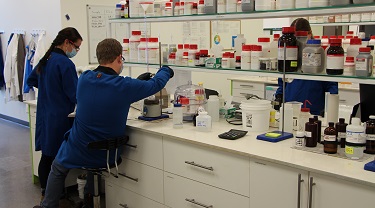For Canadian businesses facing the challenges of COVID-19, you can survive. My company has.
I own Cemondia, a Montreal company with a subsidiary called Saimen, which is based in Shanghai, and my message to Canadian businesses is one of hope.
For us, we faced the same fears you are now. At the end of January, after Chinese New Year, the COVID-19 virus was overtaking China and the government brought in strict restraint measures. It came out of nowhere for us. At the start of 2020, we didn’t really think it was a big thing and then suddenly, we’re locked out of our businesses. We had to move fast to allow people to work from home and to protect our employees.
During the first few days of isolation, I realized I had to make a plan or else Saimen—my eight-year-old entertainment and manufacturing small- to medium-sized enterprise (SME)—might not survive this business blow. It’s good to have the time to do this deep thinking, something you don’t usually have time for when you’re immersed in the everyday running of a business.
In total, we were in isolation for three weeks, but allowed back in the office after two to pick up necessary papers and technology. Once we returned to the office full time, we stayed two metres apart and had to take everyone’s temperature when they arrived in the morning. That practice continues in our building, and in many others, including the nearby Starbucks. But since mid-March, other than the temperature-taking, it’s business as usual.
I came up with 10 principles I’m convinced helped us weather the crisis and emerge stronger. I hope they’re helpful to you.
- Do an assessment of your cashflow: After looking at my books, I drafted three financial ratios we’d need to follow.
- Runway ratio: This is the cash divided by your burn rate, meaning if you have no revenue and are just paying your rent, salaries, electricity and taxes, how many months can you survive? The answer for us was 3.5 months, so I knew we had to be very careful. It also told me we didn’t need to make huge layoffs. We have 80 employees and we only let one go. We told employees we would be paying their salaries, but needed their help to do so.
- Stress ratio calculates short-term assets over short-term liabilities. It tells you whether the cash in the bank will have to go to someone, like a supplier, in two weeks. That ratio gives you an idea what kinds of things you’ll have to do such as negotiating with suppliers, talking to the bank, pushing back the rent. After doing this, we knew we’d have to push back some suppliers and turn some receivables into cash.
- Backlog ratio represents signed orders and ongoing purchase orders divided by your monthly sales. This one gives you an idea of whether things will get better or worse. We had two to three months’ sales in the backlog, so that was reassuring.
- Communication is key: In a crisis, frequent communication is essential. As soon as we were made to go into isolation, communication became our top concern. We made the time to communicate with employees about our plans, with suppliers about what they could and couldn’t provide, with the bank about any concessions that might be available and with our customers about what they could expect. To communicate with employees, we used special software and held online meetings to explain what was happening, what we needed from them and what they could expect. At the beginning, it was mostly about what our people needed such as personal protective equipment for them and their kids, families and parents, or financial assistance.
- Due diligence beforehand pays off: One question exporters, in particular, will have is how to manage supply chain risk. By the time a crisis hits, it’s almost too late to manage this effectively, but if you’ve done due diligence on your supply chain beforehand, you’ll reap the rewards. On that, we were lucky. We’ve always put in the extra effort of vetting suppliers. Some companies lost 50% of their supply chain—they just went bankrupt and disappeared. I don’t think we lost even one supplier. Even with good vetting, you should keep an eye on suppliers throughout the crisis. Give them a call; ask them if they’re able to work, seek as much information as possible. Some of them may not make it, so it’s important to be in the know.
- Keep up with the government announcements: Government will come in with some strong policies to help business, as well as some strong restrictive measures. Make sure you take advantage of the offers to help and comply with restrictions. We applied for some of the tax incentives and got that help, which is part of the reason we made it. We also had to stay updated on transportation and logistics. Could we use cars and planes? Could we deliver from there to here? When our factory was able to re-open, we had some employees coming from high-risk areas. We had to know the regulations for these people.
- Manage your stress and business continuity: I’ve never been so isolated, but I’ve also never communicated so much with employees and customers. Business continuity is very much about communication. There’s a long line of things that have to work well to maintain continuity—from marketing, sales, operations, shipping, logistics and finance. As a business owner, you know you’re going into a crisis, but you also know it’s also going to end. You’re more confined and there’s more stress and you can’t manage the stress by taking a trip to Florida. I pulled out the treadmill, read more books, watched more movies.
- Visualize a positive outcome: I always visualized that we’d be successful in the end and we’d come out of this stronger. I think that small psychological thing made a difference. It could have been despair, but I was thinking this is going to make us stronger—and it did.
- Keep a close watch on your markets and customers: The same rules apply for customers as supply chains. Stay in touch with them and understand their needs. We have offices in Montreal and while things were a bit of a mess here in China, Canada was business as usual, so they’re doing a lot of work that was related to our situation. They’re hunting for payables and buying protective equipment for us. Typically, we’re pretty strict on due diligence. We’ve had customers go bust on us, so we always check backgrounds now. Our sales people played a role by giving their customers a call. We have only one customer who went bankrupt in the crisis. It was a customer in China. Now, we’re going through it again with our customers outside China.
- Use your best resources: Upon looking back, it’s clear that certain people in our organization played a huge role in our ability to stay afloat and in our being able to keep all, but one employee. These “gatekeepers” have positive energy and they held the gate and protected our position. They all pitched in and one of the reasons we’re still here is the energy of the people who understood what they had to do. They’re shining stars of energy and positivism, pushing back suppliers, coming up with creative ideas. When you’re honest and candid and explain the situation very well, that empowers the people who care about your company.
- Support your HR: The human resources team has a lot to do with the transition to working remotely. It’s responsible for everything from buying antiseptic and protective equipment for employees to getting computers to people, so they can work remotely. Our people were doing three times more work than usual. They may also need to manage temporary or permanent layoffs. Finance was also important because members of that team had to answer calls, negotiate with banks, push back payments, try to get some customers to pay earlier. These things aren’t part of their usual responsibilities, but they’re critical in a crisis.
- View the crisis as an opportunity: Winston Churchill said, “Never waste a good crisis.” I took extra time in isolation to think about some of our processes that were outdated and I made plans to eliminate or change them. In times of crisis, it becomes easier to do things you know you should have done months ago.






